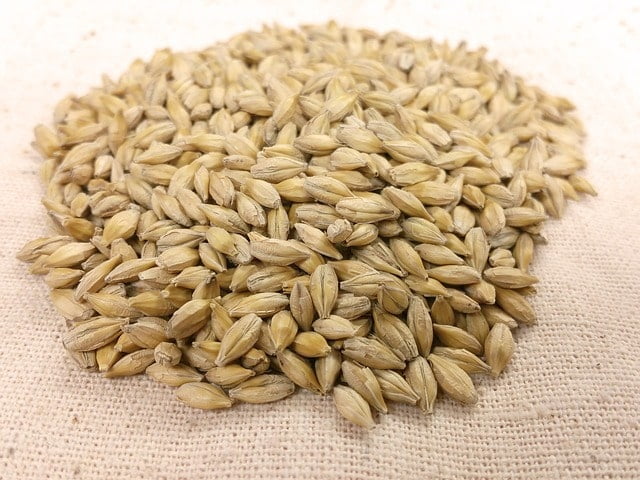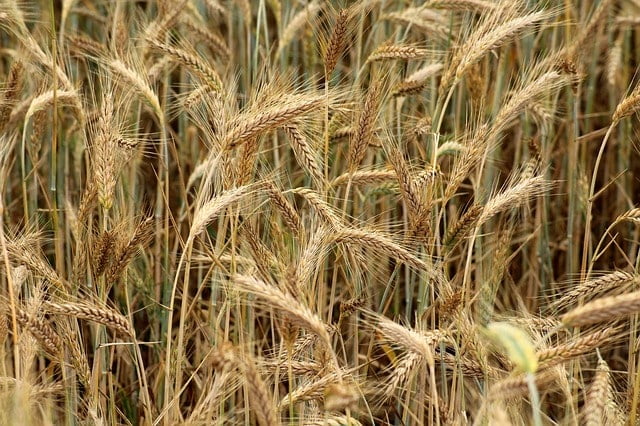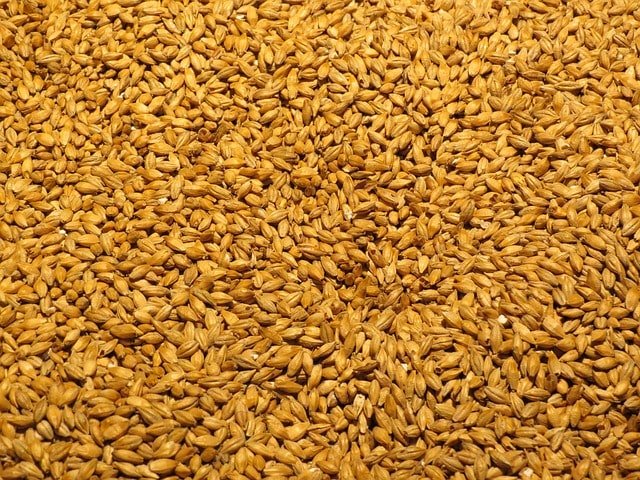What is Barley (Jau)?
Friends, barley (jau) is a grain, which has been produced since ancient times. It is also considered as the king of grains, even though today it is not in trend as compared to other grains like wheat, rice, etc.
Its scientific name is Hordeum vulgare.
In Ayurveda, it is also called “Yava“.
It is mainly grown in Russia, America, Germany, Ukraine, Canada, and India.
Barley (Jau) is a widely adaptable crop. It is popular in temperate areas where it is grown as a summer crop and in tropical areas where it is grown as a winter crop. It grows under cool conditions and has a short growing season.
Barley’s plant is erect and is about 60-150 cm in height. Its leaves are lanceolate, straight, flat, and 22-30 cm long.
After wheat, rice, and corn, barley is the fourth largest grain crop in the world. It has a little chewy consistency and a slightly nutty flavor that can complement many dishes.
This grain is commonly used in bread, stews, soups, and many wellbeing products, though it is primarily grown as animal fodder and as a source of malt for alcoholic beverages, mainly beer.
It is rich in nutrients like carbohydrates, proteins, minerals (like calcium, magnesium, iron, and phosphorous), and vitamins (like vitamin C, niacin, thiamine, and riboflavin). That’s why it is considered very beneficial in various physical problems.
Barley is beneficial in providing relief in many diseases like loss of appetite, stomach pain, diarrhea, excessive thirst, etc.
What are the Types of Barley (Jau)?
Friends, most of you may not know that this grain (jau) is available in different forms. Further in this article, I am explaining to you the main types of barley that are available in the market.
Barley Flakes
Barley flakes are made by removing the hard and outer shell of freshly harvested barley grains (and this process is called hulling). After this process, barley grains are then flattened and cut into thin slices.
Its appearance is similar to commercial oats, with a small and round appearance. Their taste is generally considered to be a somewhat nut-like flavor.
Before preparing and consuming these flakes, it is recommended to thoroughly wash them off in cool, running water to ensure they are clean.
Once barley flakes are washed, these can be boiled in hot liquid, like water, until they are softened.
It can be eaten alone or mixed with other ingredients.
The freshly cooked barley flakes can be served in a bowl with milk and served as a hot cereal, or can also be used in place of pasta or other starches in dishes like soups or stews.
These flakes are very healthy and you get lots of benefits by eating them for breakfast.
Barley Flour
Barley flour is flour, which is prepared from dried and grounded barley. Just like wheat, similarly, it is also kneaded with water to make barley bread.
Generally, there are two types of barley flour: coarse and fine. Barley groats are milled to make coarse barley flour, and pearl barley is milled to make fine barley flour.
This flour is also a constituent of composite flours used for making yeast-raised bread.
Barley Grits
Barley grits are made by husking the barley grains, then roasting them and cracking them into smaller pieces.
Hulled Barley
Hulled Barley has the highest amount of fiber, due to which it is considered to be the most nutritious type of barley.
It is slightly processed to remove only the tough inedible outer hull.
It is also called the whole form of barley. Its consumption is very beneficial in constipation.
Pearl Barley
Pearl or pearled barley, is barley that has been polished or “pearled” to remove some or the entire outer bran layer along with the hull. It is the most beautiful form of jau.
Because of its resemblance to a shining pearl, it is called pearl barley.
It is mostly used in salads and soups.
What Nutrients are found in Barley (Jau)?
Barley is rich in many nutrients.
It contains a good amount of carbohydrates, protein, dietary fiber, vitamins (folate, thiamin, riboflavin, niacin, vitamin B6, vitamin C, vitamin D, vitamin B, vitamin E, vitamin A, vitamin K), and minerals (calcium, magnesium, iron, phosphorus, sodium, potassium, zinc, etc.).
The amount of cholesterol in it is zero.
What are the Uses and Health Benefits of Barley (Jau)?
Friends, barley (jau) is rich in minerals, vitamins, and many essential nutrients that is why it has many uses and health benefits.
According to Ayurveda, the effect of barley is considered even, that is, its effect is neither too hot nor too cold. It can be consumed by grinding it and making roti (chapati) or bread of its flour, or can also be consumed by boiling it in water.
Now, here I am going to explain to you 15 important uses and health benefits of barley:
1) Barley Boosts your Immunity
Various anti-oxidants are found in barley and its leaves, which help in increasing the immunity of your body.
A study related to barley has found that its leaves have immunity-promoting properties. And it was also found that beta-glucans (β-glucans) present in its seeds can also work to promote immunity (1). Therefore, its consumption boosts your immunity.
2) Barley (Jau) Improves Digestion and is Beneficial in Constipation
This grain helps in improving your digestion. For this, barley flour also proves to be very beneficial.
Being easy to digest, it gives relief from acidity.
Apart from this, drinking it by mixing with milk is very beneficial in stomachache.
A study has shown that the dietary fiber present in barley helps in promoting intestinal health. The study has also found that it is also helpful in relieving constipation. Fermented barley extract has a laxative effect that relieves constipation. The beta-glucan and butyric acid present in it, are the main reasons for this effect of barley (1).
Therefore, along with improving digestion, consuming this grain can also prove to be very beneficial in relieving the problem of constipation.
3) Barley (Jau) is Helpful in Weight Loss
Friends, if you are overweight or obese, then you must include barley in your diet. The presence of a high amount of fiber in it helps in reducing your fat and keeps weight under control.
Jau may promote feelings of fullness and reduce hunger, and these both may help you to lose weight over time.
Barley contains resistant starch, beta-glucans, polyphenols, phytosterols, and dietary fiber. Due to the presence of all these constituents, it has an anti-obesity (weight-reducing) effect (1).
Also, the beta-glucans present in it helps in controlling appetite, which further helps in weight loss.
4) Barley is Helpful in Preventing Type-2 Diabetes.
Barley may prove to be very beneficial for getting relief from type-2 diabetes.
It helps in controlling the blood sugar level and may also improve the secretion of insulin; due to which there is a lesser possibility of getting type-2 diabetes.
It contains a good amount of fiber, which reduces the absorption of sugar, thereby maintaining the level of sugar in the blood.
Magnesium is also present in good quantity in it, which helps to manufacture about 300 types of chemicals in the body and may also fulfill the need for insulin in the body.
A study has found that this grain has a hypoglycemic effect due to the presence of phenols and beta-glucan. And this effect of barley may be helpful to provide relief in type-2 diabetes (2).
5) It is Beneficial for Heart Health
Barley is considered very beneficial in keeping your heart healthy.
Friends, there are two types of cholesterol: HDL cholesterol and LDL cholesterol. An increase in the blood level of LDL cholesterol has a bad effect on your body and it also increases the risk of heart attack or stroke. The beta-glucans present in this grain helps to reduce LDL cholesterol.
The presence of fiber and potassium in barley also helps in preventing the accumulation of excess cholesterol in your body. Due to this, the blood flow in your arteries remains smooth, and your heart also remains healthy.
A study has found that a special constituent called beta-glucan is found in barley. This constituent not only controls the increased cholesterol in your body but may also help to provide relief from the problem of high blood pressure. Along with this, it may also help in reducing the risk of heart disease due to the problem of atherosclerosis (1).
That is why the consumption of barley is considered beneficial for your heart health.
6) Barley (Jau) is Beneficial for Bone and Tooth Health
This grain may prove to be very beneficial for the health of your bones and teeth. It is rich in calcium, which is helpful in keeping the bones and teeth healthy and strong.
A study has found that barley is rich in phosphorus, which is considered very important for the development of bones and teeth. It can be helpful in the problem of osteoporosis (weakening of bones) (3).
Another study conducted by NCBI found that its use can promote bone growth. This study has also found that beta-glucans present in barley is effective in preventing alveolar bone loss (1).
7) It Provides Relief in Cold and Cough
Regular consumption of this grain helps in preventing many diseases like cold and cough.
Drinking barley decoction is very beneficial in the common cold.
8) It is Beneficial in Pregnancy
Folic acid, iron, and calcium are considered very essential during pregnancy. Iron helps in the physical and mental development of the fetus. Folic acid helps to reduce the risk of birth defects such as neural tube defects in the newborn baby. And calcium helps in controlling preeclampsia (hypertension disorder) during pregnancy. These three nutrients are found in abundance in barley.
Apart from this, its consumption during pregnancy also provides relief from constipation.
Due to these reasons, the consumption of barley is considered beneficial in pregnancy.
9) Barley is Beneficial in Arthritis
The consumption of barley may prove to be very beneficial for people suffering from arthritis. The anti-inflammatory properties present in it can help in reducing the inflammation related to arthritis.
10) It is Beneficial in Gallbladder Stones
High triglyceride levels in the body increase the chance of gallstone formation. By consuming barley, the fiber present in it helps to keep your triglyceride levels balanced, which reduces the chances of stone formation.
Consuming barley may be beneficial in gallstones. A study in this regard has found that the fiber present in it can work to dissolve the gallstones to some extent (4).
11) It is Helpful in Preventing Cancer
Consumption of barley is helpful in reducing the risk of cancer. The antioxidants, fiber, and minerals present in it help in preventing cancer.
A study conducted by NCBI has found that substances like beta-glucan, phytosterols, phenolics, and resistant starch are present in it. Due to their presence, anticancer (cancer cells destroying) properties are found in barley. Its consumption may primarily help in preventing cancer-related to the liver and stomach (1).
12) It Reduces the Risk of Anemia
The most common cause of anemia is iron deficiency. This grain contains a good amount of iron. Therefore, if you include barley or its flour in your diet, your iron deficiency is fulfilled and it helps in preventing anemia.
13) It is Beneficial for Sexual Health
Barley is beneficial for your sexual health.
The zinc present in it is a required nutrient for your sexual health. Deficiency of this nutrient leads to low sperm count. Zinc also helps in increasing the level of testosterone in men. This has been acknowledged in a study related to foods that promote sexual health.
In another study, it has been found that this grain has aphrodisiac properties.
Therefore, on this basis, it can be said that the consumption of barley is beneficial for sexual health.
14) Benefits of Barley for Skin
The use of barley is very beneficial for your skin.
In a study, it has been found that the extract of fermented barley is beneficial in the wounds associated with the skin.
Apart from this, its use also helps in relieving atopic dermatitis – the problem of skin rash due to inflammation (1).
15) Benefits of Barley for Hair
The use of barley is also very helpful for your hair health.
A study done on barley has also proved that a special substance called Procyanidin B-3 present in it, has the property of promoting hair growth (5).
Therefore, along with its consumption, applying its water to the hair helps in keeping your hair healthy.
What are the Side Effects of Eating Barley (Jau)?
Friends, above in this article I have explained to you the uses and health benefits of eating barley, but if you consume it in excess amount, you may experience the side effects (disadvantages) of barley.
Now below I am explaining to you the side effects (disadvantages) of eating barley:
- This grain has laxative, i.e. stool softening property (1). Because of this, if you consume too much of it, you may suffer from diarrhea.
- It contains high amount of potassium, so its excess consumption can cause problems like abdominal pain, vomiting, nausea, etc.
- It has an anti-diabetic effect (1). For this reason, if it is consumed in excess, the level of your blood sugar may become very low. Therefore, diabetic patients should be careful while consuming barley.
- Some allergic effects are also found in Barley (jau), due to which a child may also complain of allergy due to its consumption (6).
How to Use Barley (Jau)?
Friends, you can use barley by including it in your daily diet as follows:
- It can be consumed by making soup of its seeds.
- You can consume barley flour by making rotis (chapati) of it.
- You can also consume bread made from its flour.
- It can also be used for drinking by making juice of its leaves.
- You can make barley porridge (sweet or salty) and eat it in breakfast.
- Its seeds can also be eaten in vegetable salad.
- You can also make and drink barley water. Honey or lemon juice can be added to make it taste better.
- It can be boiled and eaten as a substitute for rice.
Conclusion
Barley (Jau) is a very beneficial grain and you must include it in your diet. Its consumption has many health benefits like it increases your immunity, helps in reducing weight, increases digestion power, keeps heart-healthy, is beneficial in blood sugar, and is beneficial in arthritis.
To take all its benefits, you should consume it in the right quantity and in the right way. Barley can also cause side effects if it is consumed in excess. If you are suffering from any disease, then please consult your doctor before consuming it.
Frequently Asked Questions
Question: Are wheat and barley the same thing?
Answer: Wheat and barley both are cereals of the grass family, but they are not the same.
Both are different.
Question: How is barley flour made?
Answer: Barley seeds are finely ground and made into flour.
Question: Where is barley found and grown?
Answer: In India, it is grown in Uttar Pradesh, Kashmir, Bihar, Punjab, Orissa, Rajasthan, Gujarat, and Madhya Pradesh. Apart from India, it is found or grown in Germany, Russia, Canada, and Ukraine.
Question: What is Barley called in India?
Answer: In India barley is popularly known as Jau.
————————————————-
References:
1) Molecular Mechanism of Functional Ingredients in Barley to Combat Human Chronic Diseases
https://www.ncbi.nlm.nih.gov/pmc/articles/PMC7149453/
2) Assessment of the Phenolic Profiles, Hypoglycemic Activity, and Molecular Mechanism of Different Highland Barley (Hordeum vulgare L.) Varieties
https://www.ncbi.nlm.nih.gov/pmc/articles/PMC7072826/
3) Physiological and behavioral study on depressed rats model treated with Hordeum vulgare extract referenced to SSRI class
4) The influence of barley fiber on bile composition, gallstone formation, serum cholesterol and intestinal morphology in hamsters
https://pubmed.ncbi.nlm.nih.gov/2166543/
5) Procyanidin B-3, isolated from barley and identified as a hair-growth stimulant, has the potential to counteract inhibitory regulation by TGF-beta1
https://pubmed.ncbi.nlm.nih.gov/12473061/
6) Clinical and Laboratory Findings of Barley Allergy in Korean Children: a Single Hospital Based Retrospective Study
https://www.ncbi.nlm.nih.gov/pmc/articles/PMC6970078/
————————————————-
Disclaimer: This article is intended for informational purposes only. Any information associated with this article should not be considered as a substitute for prescriptions suggested by local health care professionals.
————————————————-
Also, Read This:
1) Bananas: Calories, Nutrition Facts, & Health Benefits
————————————————-



